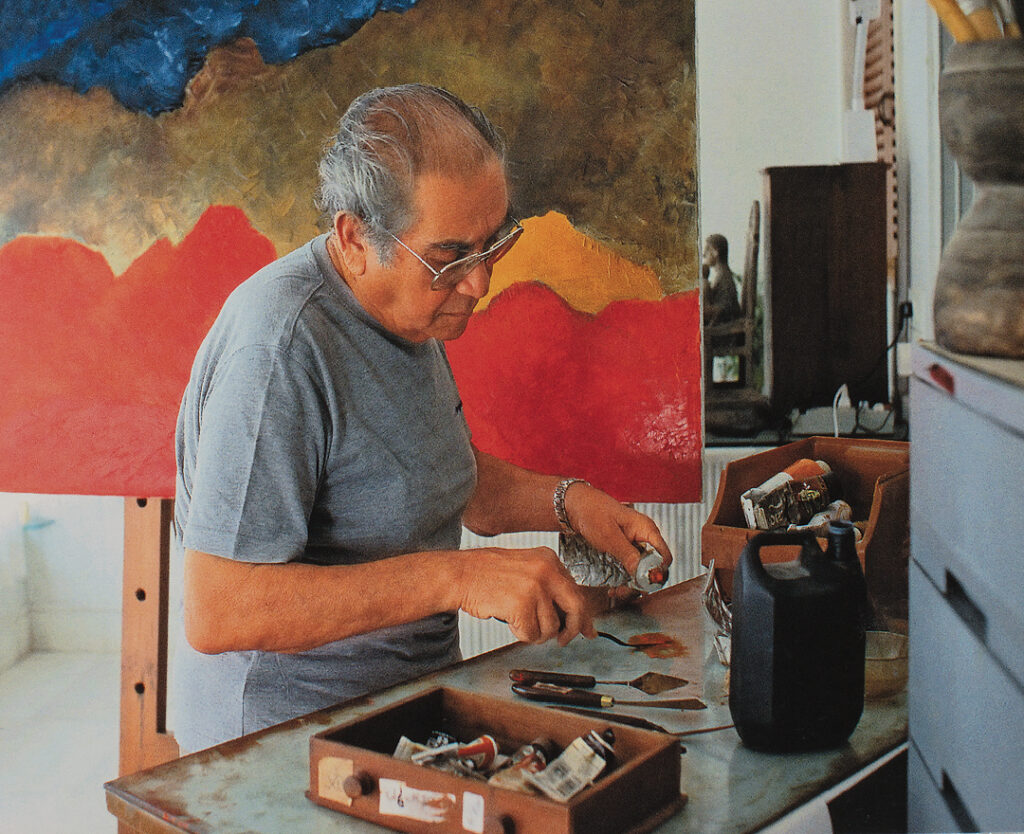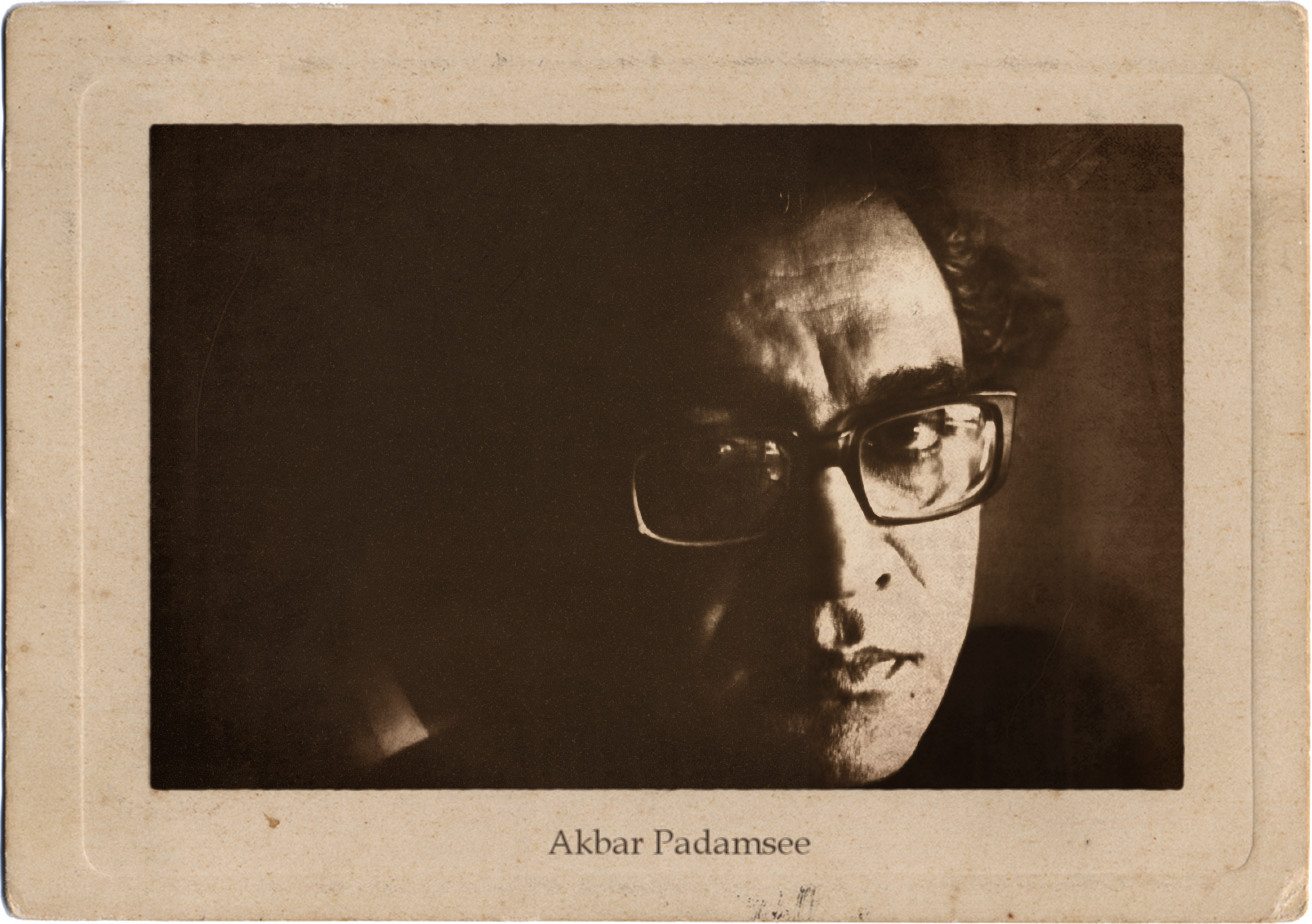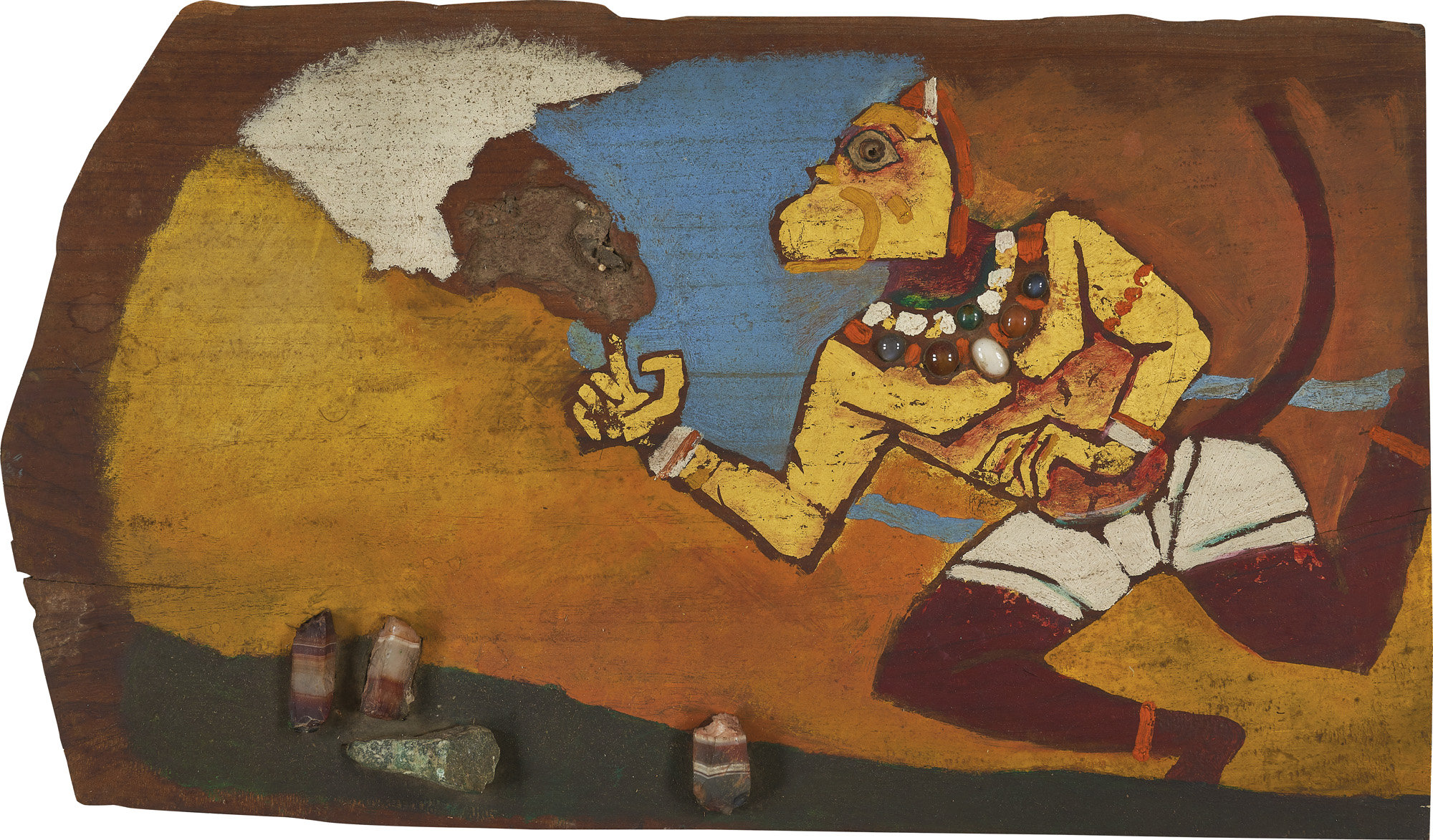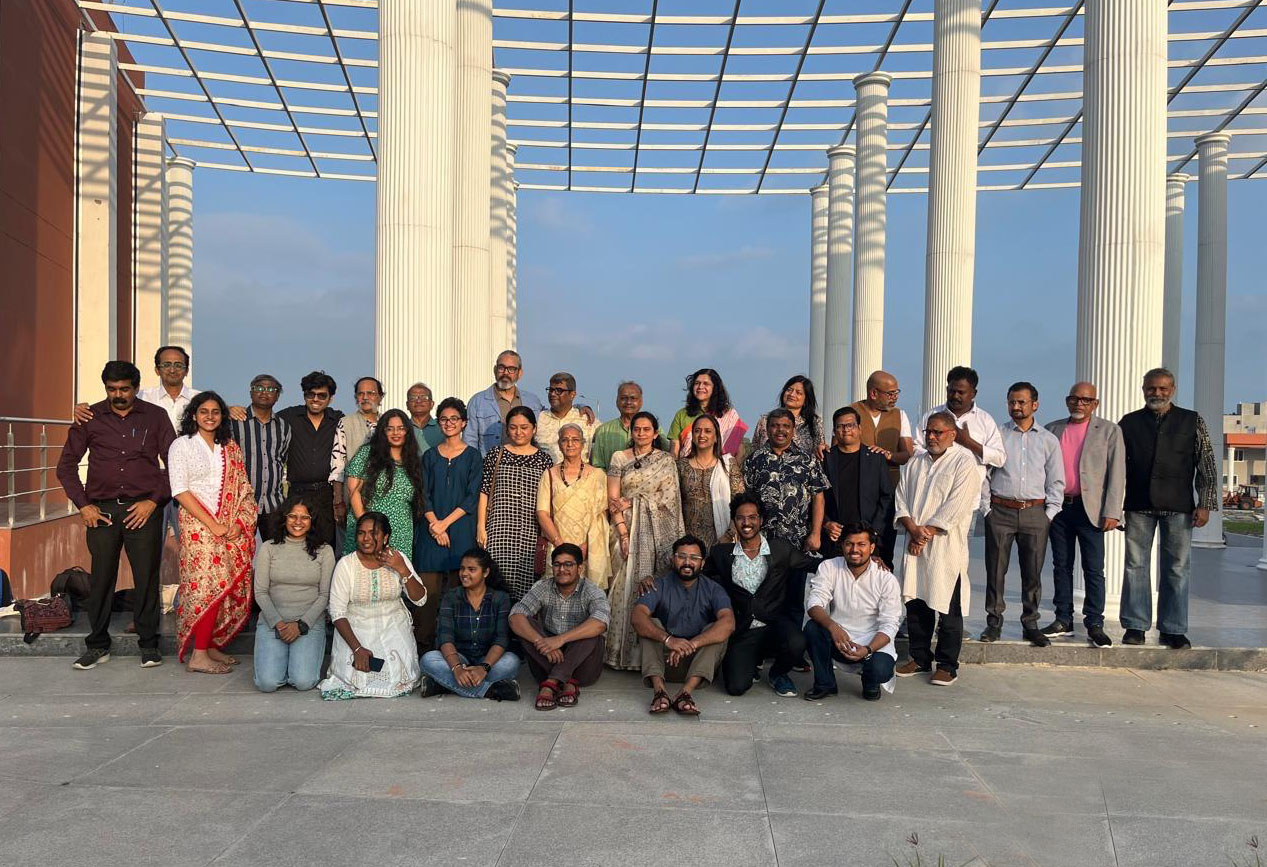On 7th January 2020, the Governor of Maharashtra, Bhagat Singh Koshyari presented the first ‘Vasudeo Gaitonde Kala Jeevan Puraskar’ (Life Time Achievement Award in the Field of Art) to Late Akbar Padamsee (posthumously) at the 60th Maharashtra State Art Exhibition held at Jehangir Art Gallery. An evening earlier, Akbar Padamsee passed away at the Isha Yoga Center in Coimbatore. He was excited when he heard of receiving the award that was dedicated to him in the name of his artist friend Vasudeo Gaitonde who was his senior by few years at Sir J. J. School of Art.
Born on April 12, 1928, Padamsee’s ancestors hailed from Vāghnagar, a village in the Bhavnagar district of the erstwhile Kathiawar, now part of Gujarat. His grandfather was the sarpanch of the village and earned the title Padmashree or Padamsee after distributing his entire granary to the village during a famine. The family had belonged to Charana community, known as Deviputras (sons of the goddess). Charanas were essentially litterateurs and folklorist. Youngest amongst eight siblings, Akbar, as a child, stayed aloof and preferred to amuse himself with books. He also displayed an ardent interest in art that developed through photographs of gods and goddesses his nanny shared with him. The antique Irani furniture and flower vases that adorned his home also inspired him. At the age of four, he took to drawing in the margins of the account books and ledgers at his father’s shop of imported glass lanterns on Chakla Street, South Mumbai. In his primary school, he would draw caricatures on the black board before the class teacher would arrive, when the teacher would enquire, the classmates would point out to Padamsee, but she would never believe that such a young boy’s drawings had a mature finesse.

Akbar Padamsee
He was 11 years old when he accidentally stepped on a rusted nail, leading to a serious injury. While the wound was cured, the psychological impact left him speechless. It was more the will to speak that had gone away. Apparently, he did not speak a word for about nine years. Instead, he focused his energies on reading and art. After his father passed away, his elder brother Nicky (Nurudin), eight years his senior served as a father figure and gave him a book on Freud’s Introductory Lectures on psychoanalysis, dream interpretations and the psychopathology of everyday life. Not quite realizing what it was about, it was like tasting in advance what was going to come. Padamsee reciprocated with the writings of philosophers like Heidegger, Sartre and the likes; he believed that thinking was a system before one could paint. The influence of this can be seen in his later works. He chose to study at Sir J.J. School of Art, but Nicky advised him to join St. Xavier’s High School. At St. Xavier’s High School, Fort, he had a very strange school life. He was a back-bencher and day-dreamer who was always ridiculed by his classmates over his speech impediment. During school examinations, his elder brother helped him study, and somehow saved him from the kind of education that was doled out in those schools. Later, he met his first mentor, drawing teacher Shirsat, a water colourist, who tutored him in the medium, wines in Khandala, and nudes at a special class at Charni Road, in preparation for his studies at the Sir J. J. School of Art, enabling him to join the course directly in its third year.

Padamsee’s years at the art school came at a time when a lot of undercurrents were passing through the Indian Art world, the most important being the formation of the Progressive Artist Group. He learned the academic style of painting that was popular in those times but did not restrict himself to just that. Even as a young adult, he enthusiastically learnt what was beyond the norm. He would skip classes and spend hours in the college library, pouring over books and acquainting himself with the work of the Masters. He was more interested in the science of art inspired by formal conundrums and conceptual schemes in approaching his work and would often investigate Durer’s drawings, Piero della Francesca’s studies for the curve of a queen’s neck – he had made a complex grid as if it were for a bridge. One day, he found T.A. Gopinath Rao’s Elements of Hindu Iconography in the library and was amazed by the precise directions that were given to the bronze sculptors. It was later at the school of art that he used the concept of the grid as geometry of proportion; however, it was at the elementary level. He also read a book on principles of Chinese painting. However, it was only later that he developed these ideas further .Of his early days spent at Sir J. J. School of Art, he once claimed: “In those days, learning painting in that tree-studded campus was a heady experience”. Professor Shankar Palshikar introduced him to miniature paintings and burnishing the surface with cowrie shell to spread the color evenly to get a glaze effect, but Padamsee would be lazy to do it all by himself. His early work during that year started with detailed study of heads, prophets and different couples. Padamsee’s subjects appeared astute with a pondering gaze. He disliked the sentimental and refused to submerge his figures with that feeling. This is why; even when he portrays his nude protagonists, they lack any outward sensuality. Padamsee studied French and his art teacher, Shankar Palsikar, encouraged him to study Sanskrit, which later became the basis of Padamsee’s thought process and the foundational structure for his art.

After his completing his diploma in painting, he took up sculpture for a year; one afternoon, when he was rhythmically beating the sheet metal with a hammer to make a relief sculpture. In the adjacent studio, another professor called Sabannavar, from the metal-craft department, was busy with his work. Suddenly, he barged into Padamsee’s space and asked him to stop work. The cause of the professor’s anger was the sound that the artist was producing while beating the sheet. He knew from the sound that Padamsee was doing something wrong. He asked Padamsee if he was disturbed, to which Padamsee replied with a yes. Padamsee was thus sensitized to the importance of sound in art-making. Later, he would apply this lesson an accidental insight to his pictorial practice. In an interview with Homi Bhabha, he recalls: “The professor’s interpretation intrigued me and I decided to experiment with sound. I took a very heavy aluminum holder in which I inserted a felt pen. I then dipped it in ink and started hitting on my drawing paper stretched on the board, really hard. Next, I tried this on my charcoal and oil works on canvas board and had a whole show around these works. I was going by the sound. Finally, an image would emerge, and it was often said that I painted with dots, but in reality I was painting with sound.”
Padamsee was a student associate, not a formal member, of the Progressive Artist Group, founded by F.N. Souza, with Raza and M.F. Husain as members, among others, with whom he developed a lifelong friendship. He along with Tyeb Mehta helped in installing works of the Progessives and other seniors like Mohan Samant. His father had a cyclostyle machine, with which he made copies of a catalogue of the show the Progressives had put up. That probably made him a blue-eyed boy. Later in 1948, an exhibition of paintings of student artists comprising of fifty artworks was organized by the Progressive Artist Group and was shown at the Bombay Art Society’s Salon. Francis Newton Souza, the then Secretary of the Progressive Artist Group said the exhibition was a novel idea and intended to draw attention of the public and art critics to the works of art students. Padamsee’s paintings were highly appreciated by the art critics.

In 1950, a former student visited the school of art and showed interest in the works of the students. The senior was S.H. Raza. Padamsee told Raza that he was given third-class. Raza said he should have gotten a first-class with this work. Raza had received a scholarship to go to Paris and offered to take him along. Padamsee shared the news with Palshikar, who said he should see India first; next Padamsee brought himself a ticket to Madurai and visited the Meenakshi temple. Later in 1951 along with Raza he sailed to France, where Padamsee met the surrealist Stanley Hayter and started painting at a local studio, Atelier 17, and held his first show at Galerie Saint Placide in 1952. His first exhibition in Paris, which required artists to stay anonymous, saw Padamsee sharing the prize awarded for it by the French Journal d’Arte with the surrealist Carzou, then in his 40s. Thus began a never ending journey of honours and awards. He was featured in the 1959 Tokyo Biennale, he received a gold medal from the Lalit Kala Akademi in 1962 A fellowship by the Rockefeller Foundation in New York followed in 1965, and in 1969 the prestigious Jawaharlal Nehru Fellowship, he was bestowed by Padma Bhushan and Kailash Lalit Kala award in 2010. His figurative works from the 1950s gave way to bronze heads the human expression was a lifelong preoccupation of Padamsee to photography. Exhibitions have been held at institutions worldwide, including the Rubin Museum of Art in New York and London’s Royal Academy of Art.

Padamsee always approached his art with deep thought and intense focus, constantly pushing boundaries and innovating in his creative process. During his illustrious career, Padamsee explored a wide range of mediums, and managed to remain fiercely experimental and individualistic. His artistic oeuvre is a formal exploration of a few chosen genres — prophets, heads, couples, still-life, grey works, metascapes, mirror-images and tertiaries, across a multitude of media oil painting, plastic emulsion, water colour, sculpture, printmaking, computer graphics, films and photography. His early portraits and landscapes in varied mediums of painting, drawing and etching demonstrate a quasi-spiritual style of working. His oils have been characterised by a deep intensity and luminescence while his drawings exude a serene grace.
Akbar Padamsee has always been eclectic, drawing his inspiration from various sources. He spoke at length about the western and eastern philosophy, be it Paul Klee’s The Thinking Eye or Mammata’s Kavyaprakasha. He was on board with anything that helped him give an adequate structure to his own art. Never one up for an easy summing up of art, his work continues to take the viewers through an intense journey unmasking the mysteries of art, through his work and life.
Quoting Padamsee’s favourite line from the Isa Upanishad, there’s formlessness about great poetry that moves you. Addressing the sun, the speaker says, ‘Remove the glare, so that I can look at you face-to-face because I’m the very person that’s yonder; I’m the sun myself. When the heat of the sun reaches me, let the body be reduced to ashes; but may the mind remember, remember, remember… Om shanti, shanti, shanti…’
Abhijeet Gondkar
February 2020, Mumbai

(Abhijeet Gondkar is an independent writer and curator based in Mumbai. The above extracts are from inputs by Bhanumati Padamsee, Jehangir Nicholson Art Foundation and further readings of Padamsee’s conversation with Homi Bhabha published by Marg. The above article was published as a tribute to Akbar Padamsee in ‘Roopa-Bheda’ 2019-20, an annual publication of Sir J.J. School of Art, Mumbai)
Art Blogazine 2024




